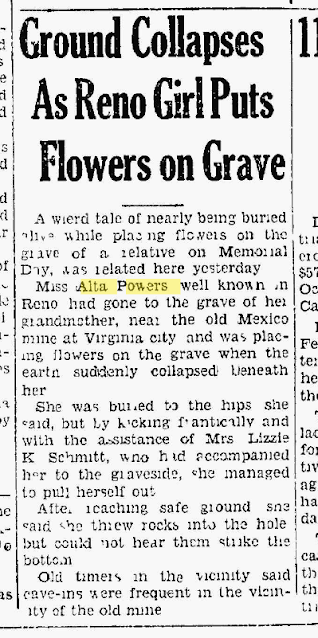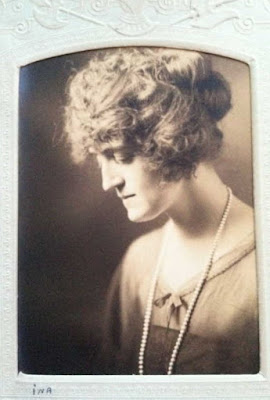The town of Heppner, Oregon during the flood of 14 June, 1903
National Weather Service Public Domain picture
The theme for this week's 52 Ancestors in 52 Weeks challenge is Power. I have chosen to explore the power of water and the Heppner Flood of 1903. The power of moving water can be harnessed for many useful purposes when it can be managed carefully. Moving water has helped operate mechanical devises such as gristmills and sawmills for thousands of years. It helped usher in the Industrial Revolution in Britain. Water in canals could be used to move goods and people long distances. Hydraulic mining during the Gold Rush era used high pressure jets of water to dislodge rock to then extract gold. Even tidal power can be harnessed to generate electricity.
Sadly the power of water can be responsible for a great deal of destruction when it is uncontrolled. This is the story of the neighboring towns of Heppner, Lexington and Ione Oregon on the 14th of June, 1903. My paternal Great Great Grandfather, Josiah Stewart Boothby, was living in Lexington at that time working as a rancher and farmer. I had no idea that this area endured so much devastation until I began my research into this side of the family. The death toll was 247 souls and remains the deadliest natural disaster in Oregon history, and the second deadliest flashflood in the United States, behind the 1889 Johnstown flood and ahead of the 1972 Black Hills flood. The flood caused over $600,000 in damage, equivalent of $17 million dollars today (Wikipedia Heppner Flood of 1903).
The Heppner Gazette 18 June, 1903
The town of Heppner is located in eastern Oregon, just south of US-84 and the Columbia River. It lies in a small, tight valley that contains a small little stream that drains into the Columbia River. Willow Creek is about ankle deep, and can even run dry during the summer. However, on June 14, there was an exceptionally strong thunderstorm which dumped torrential rain and hail on the watershed of Willow Creek. Within 15 minutes, smaller streams emptied into Willow Creek, which in turn sent water towards Heppner, which at that time had about 1,500 residents. The rain and hail were so loud most people took shelter inside their homes, contributing to the death toll. It is thought that the rattle of hail masked the roar of the muddy water, trees, cattle and buildings that came down the canyon and into town. The water was so powerful it picked up dozens of occupied houses and moved them downstream. A third of the town of Heppner was gone, as well as a quarter of its population in a very short period of time. Excerpt from the Heppner Gazette....
"Words cannot express the horror, the awful destruction. Entirely helpless, from the hillsides, the survivors watched the terrible waters take there course. To attempt to battle the great waves meant only suicide without being able to accomplish anything."
"This city is a heap of ruins. Twisted tree trunks against which are piled masses of wreckage mark the residence districts. Scattered throughout this wreckage and the bruised and distorted bodies of the dead..."
"...the large two story residence building of T. W. Ayres left its foundation and swung around into May Street and crashed into and lodged on some wooden buildings just back of the Palace Hotel....Mr. Ayres was at the power house and his family was at home, when the building started. The family ran upstairs and were rescued when the building stopped ...the family came down on a ladder and were taken out uninjured."
"Phil Cohn, whose family was out of town, was at home and asleep when the flood struck his house, he stayed with the building until it went to pieces and for a mile he clung to the wreckage, going under a half a dozen times or more, and was finally able to crawl out more dead than alive in W. O. Minor's alfalfa field."
The little town of Lexington, where Josiah Boothby lived, was down stream of Heppner. The telegraph and telephone lines were out, so Lester Matlock and Bruce Kelly rode their horses down the valley, racing the moving water, and warned the ranchers and residents of Lexington and Ione of the approaching disaster. Lexington was badly damaged, but Ione escaped any destruction. When the flood had gone, it was apparent what force the water had. These are excerpts from another local paper, talking specifically about Lexington, Oregon.
"Fifty men were at work this morning breaking away the piles of trash expecting at any moment to come across the body of some unfortunate who went down in the flood. Yesterday morning, the body of an elderly lady, the wife of ex-judge Keithly, was found in Andrew Rainey's field two miles below Lexington. Mrs. Keithly was in Heppner when the flood came. As Heppner is nine miles from Lexington, it can be readily seen what force the water must have had to carry a body that distance.
The paper also listed monetary damages suffered by its residents...
"B. M. Booher, one of the prettiest cottages and finest orchards in Lexington, $1,500 ; W. J. Davis, orchards and gardens ruined, $2,000; J. S. Boothby $1,500 across the creek; Mrs. Penland, owner of the principal portion of the townsite and several orchards up the creek, will loose $8,000......while some of these figures seem small it means everything to the poor unfortunates. Their all is gone. In many cases not even the soil is left in fit condition to cultivate. Rocks are embedded in the slime, which covers the land to the depth of 12 to 20 inches."
Willow Creek dam above the town of Heppner, constructed by the Army Corps of Engineers in 1981 to prevent further destructive flooding.
In 2003, a three-panel stone monument was placed in the town of Heppner to mark the 100th anniversary of the disaster. The monument also lists the names of the victims of June 14, 1903.
The present day Community Bible Church in Lexington, Oregon. It was originally the Methodist Episcopal Church when Josiah Boothby and his family attended, and is best known for being swept off its foundation during the Heppner flood of 1903. It rode the flood tide down the street and crashed into the Congregational Church. It was retrieved, replaced and restored and continues to serve the community at its original site.
Josiah Stewart Boothby died in 1905, just two years after the disaster. He was buried in the Penland Cemetery. I have to think that this event had a profound effect on his health and his family. His monetary losses were substantial. My Great Grandfather, Josiah Thomas, was also living and working as a farmer in Lexington in 1900 with his wife Lillie Mae Hayman Boothby. They had a home there with Lillie's four children by her first marriage (Ciola, Harry, Clyde and Marion), as well as Thomas Josiah Boothby, their first born together. Although he is not listed with other town members as having lost a home or property, it took the town quite a long time to rebuild the railroad bed and other damaged infrastructure to enable it to function economically as it did before 1903. By 1910 my Great Grandfather was farming in Grass Valley, Oregon, so he may have not been able to make a living in Lexington to support his growing family. Lexington remains a very quiet little town today, with a population of a little over 200 people, up from 185 in 1910. Residents are mainly sheep and cattle ranchers, and wheat farmers.









































